Last Updated on December 13, 2024 by Kittredge Cherry
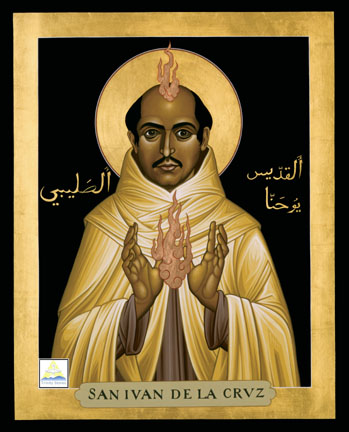
“The Dark Night of the Soul,” a spiritual classic with homoerotic overtones, was written by 16th-century Spanish mystic Saint John of the Cross, also known as San Juan de la Cruz. His feast day is Dec. 14. It always near the winter solstice, the longest night of the year in the northern hemisphere.
Like some other mystics, John of the Cross (1542-1591) used the metaphor of erotic love to describe his relationship with Christ. Since Jesus was born male, his poetry inevitably celebrates same-sex love. Christian tradition tries to make this kind of poetry into heterosexual eroticism by considering the soul and the church to be female while God is male.
John of the Cross wrote mystical poetry
John was born into a family that was “converso,” descendants of Jewish converts to Catholicism. His father was disinherited for marrying his mother, Catalina, an orphan from a lower class. Their poverty worsened after his father died when John was three years old. The situation became so bad that his older brother died of malnutrition and John’s growth was stunted by rickets. His adult height was less than five feet tall.
John of the Cross spent most if not all of his life in al-Andalus, a region of Spain and much of the Iberian Peninsula that was ruled by Muslims (or Moors) from the 8th to 15th centuries. Theories suggest that his mystical imagery was influenced by the Jewish mystical tradition of Kabbalah and by Islam, particularly the Sufi esoteric traditions pioneered by Rumi. Al-Andalus was a center of business, culture and religious tolerance where Christians, Jews and Muslims lived side by side.
Hear how passionately John speaks about Christ in these verses translated by A.Z. Foreman:
O night that can unite
A lover and loved one,
A lover and loved one moved in unison.
And on my flowering breast
Which I had kept for him and him alone
He slept as I caressed
And loved him for my own.
(The whole poem is reprinted in the original Spanish and in English at the end of this post).
John, a Carmelite friar, likely wrote these beautiful verses while imprisoned in a latrine for trying to reform the church. Later he wrote detailed commentary explaining the poem’s many layers of meaning in two treatises, both unfinished: “Dark Night” and “Ascent of Mount Carmel.”
“The Dark Night of the Soul” is open to various interpretations, but is usually considered to be a metaphor of the soul’s journey to union with God. The concept has also been borrowed by the ecology movement for discussions of “the dark night of the earth’s soul.”
John of the Cross also used same-sex imagery to describe divine love in “The Spiritual Canticle.” He wrote, “The love Jonathan bore for David was so intimate that it knitted his soul to David’s. If the love of one man for another was that strong, what will be the tie caused through the soul’s love for God, the Bridegroom?” Likewise he wrote about the “delightful wounds” that his soul experiences in encounters with the Beloved in “The Living Flame of Love.”
Writings by John of the Cross fit into a tradition of queer “bridal mysticism” of a same-sex “mystical marriage” to Jesus include other men honored by the church, such as Bernard of Clairvaux, John of La Verna, and Bernardo de Hoyos.
John of the Cross shared a spiritual bond with his friend Theresa of Avila. Both were Carmelites who shared a desire to reform the order. Teresa of Avila, the first woman to be declared a “doctor of the church,” has been interpreted as a lesbian because of some relationships she had. Many people associate her with sexuality because of the famously erotic statue “The Ecstasy of Saint Teresa” by Bernini.
[This profile was attacked in the article “An Act of Spiritual Malfeasance Against St. John of the Cross” at the traditional Catholic website CatholicStand.com., which accused author Kittredge Cherry of “the mortal sin of cultural appropriation” and threatened “excommunication from progressives.” Discussion on her Facebook page has more than 100 thoughtful and supportive comments.]
Writers explore John of the Cross from gay and queer viewpoints
Writings by John of the Cross are the basis of a controversial 2022 queer theology book with a Latinx lens: “Queer God de Amor” by Miguel H. Diaz. It was finally released in September 2022 by Fordham University Press after being cancelled at the last minute in June by a different Catholic press.
 The scholarly book looks at the human-divine bond using the metaphor of sexual relationship from writings by John of the Cross. Highlighting the idea of God as lover, Diaz retrieves a preferential option for human sexuality and outs God from heteronormative closets. His hermeneutic takes seriously the lived experiences of LGBTQ+ people and builds on the “indecent theology” of Marcella Altaus-Reid. John of the Cross lived in Spain and wrote in Spanish, but English-language readers mostly know his work through British translators and interpreters. Diaz recontextualizes him by directly examining his Spanish texts and life in Spain. The author is a former US ambassador to the Vatican and holds the John Courtney Murray Chair in Public Service at Loyola University in Chicago.
The scholarly book looks at the human-divine bond using the metaphor of sexual relationship from writings by John of the Cross. Highlighting the idea of God as lover, Diaz retrieves a preferential option for human sexuality and outs God from heteronormative closets. His hermeneutic takes seriously the lived experiences of LGBTQ+ people and builds on the “indecent theology” of Marcella Altaus-Reid. John of the Cross lived in Spain and wrote in Spanish, but English-language readers mostly know his work through British translators and interpreters. Diaz recontextualizes him by directly examining his Spanish texts and life in Spain. The author is a former US ambassador to the Vatican and holds the John Courtney Murray Chair in Public Service at Loyola University in Chicago.
Toby Johnson, ex-monk, gay spirituality author and activist, connects the Dark Night of the Soul with gay consciousness in his writings. Johnson summed up his understanding for Q Spirit:
“John of the Cross is a wonderful example of homoerotic spirituality. Andrew Harvey places him high in his collection of ‘Gay Mystics.’ The image in the poem ‘On A Dark Night’ is of becoming one with Christ in the experience of making love with a strange man in a park late at night–and waking to find they are lying in a field of lilies. This is the idea that shows up in ‘Les Miserables’ in the lyrics: ‘To love another person is to see the Face of God.’ John of the Cross, as an icon/archetype of spirituality, is about seeing God in unexpected places and struggling with contradictions in order to arrive at seeing beyond contradictions. A very queer way to arrive at being one with God.”
He fleshes out this idea in a full essay at TobyJohnson.com.
“Love’s Urgent Longings: St John of the Cross” by Christopher Hinkle explores sexuality and gender as a chapter in the 2007 book “Queer Theology: Rethinking the Western Body,” edited by Gerard Loughlin.
Other gay writers who explore the queer dimensions of John of the Cross include Terence Weldon. he explains why John of the Cross is important for LGBTQ people of faith at the Queer Spirituality Blog.
John of the Cross in art
In the icon at the top of this post, Brother Robert Lentz shows John with the living flames that he described in this poetry. The inscription by his head puts his name in Arabic to honor the Arabic heritage that John may have received from his mother. Prints are available from Amazon and Trinity Stores.
Richard Stott, a Methodist minister and art therapist in England, created three large paintings based on “The Dark Night of the Soul.” The triptych is called “Intimacy with Christ.”
“Juan de la Cruz” was sketched with light pastels on black paper as dark as the night of the soul by Tobias Haller, an iconographer, author, composer, and retired vicar of Saint James Episcopal Church in the Bronx, still assisting at a parish in Baltimore, Maryland. It also shows Jesus on the cross shown from high above, based on a drawing by John of the Cross himself. That sketch became the basis of the famous 1951 painting “Christ of Saint John of the Cross” by surrealist Salvador Dali.
Haller is the author of “Reasonable and Holy: Engaging Same-Sexuality.” Haller enjoys expanding the diversity of icons available by creating icons of LGBTQ people and other progressive holy figures as well as traditional saints. He and his spouse were united in a church wedding more than 30 years ago and a civil ceremony after same-sex marriage became legal in New York.
John of the Cross and the Song of Songs
In an unusual icon, John of the Cross is surrounded by scenes from the Song of Songs (also known as Song of Solomon), the book of the Bible that celebrates erotic love. It is located at the Church of the Carmelite Friars (Iglesia de los Padres Carmelitas) in Segovia, Spain. The saint’s remains are enshrined there. The icon was made on commission by the Carmelite Monastery of nuns in Harissa, Lebanon.
“A typical icon will have a central image of the saint (like this one) and the smaller images framing it will be of events from the saint’s life. In this icon however, the framing images are of the Maiden from the Song of Songs and her Beloved! Effectively, the icon communicates to the viewer that John is the Maiden of the Canticle and invites the viewer to join him in this role,” says Kevin Elphick, a Franciscan scholar who studies the ways that saints cross gender boundaries. He photographed the original icon in its church home while retracing the footsteps of John of the Cross on a trip to Spain in 2015.
Individual images of the scenes from Song of Songs are posted with detailed commentary on a Polish Carmelite website at http://www.karmel.pl/ikona-z-ciemnosci-do-swiatla/.
The Dark Night of the Soul
by John of the Cross
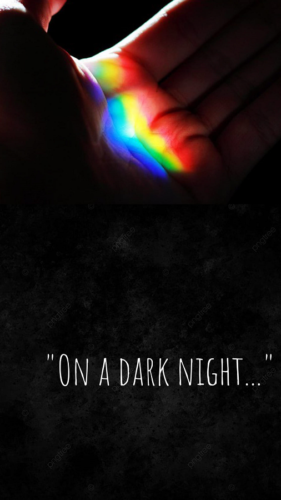
“On a Dark Night…” by Después De Zaqueo Menor illustrates the first line of the poem in a common English translation.
1. One dark night,
fired with love’s urgent longings
– ah, the sheer grace! –
I went out unseen,
my house being now all stilled.
2. In darkness, and secure,
by the secret ladder, disguised,
– ah, the sheer grace! –
in darkness and concealment,
my house being now all stilled.
3. On that glad night,
in secret, for no one saw me,
nor did I look at anything,
with no other light or guide
than the one that burned in my heart.
4. This guided me
more surely than the light of noon
to where he was awaiting me
– him I knew so well –
there in a place where no one appeared.
5. O guiding night!
O night more lovely than the dawn!
O night that has united
the Lover with his beloved,
transforming the beloved in her Lover.
6. Upon my flowering breast
which I kept wholly for him alone,
there he lay sleeping,
and I caressing him
there in a breeze from the fanning cedars.
7. When the breeze blew from the turret,
as I parted his hair,
it wounded my neck
with its gentle hand,
suspending all my senses.
8. I abandoned and forgot myself,
laying my face on my Beloved;
all things ceased; I went out from myself,
leaving my cares
forgotten among the lilies.
From: THE COLLECTED WORKS OF ST. JOHN OF THE CROSS, translated by Kieran Kavanaugh, OCD, and Otilio Rodriguez, OCD, revised edition (1991). Copyright 1991 ICS Publications.
La noche oscura del alma
(original Spanish)
por San Juan de la Cruz
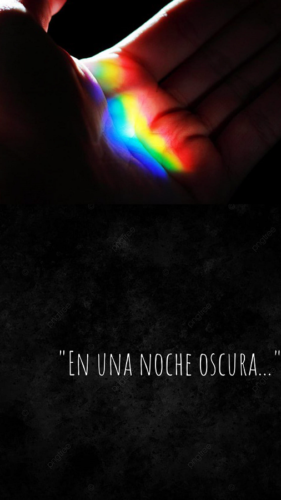
“En una noche oscura…” by Después De Zaqueo Menor illustrates the first line of the poem in the original Spanish.
1. En una noche oscura,
con ansias, en amores inflamada,
¡oh dichosa ventura!,
salí sin ser notada,
estando ya mi casa sosegada;
2. a escuras y segura
por la secreta escala, disfrazada,
¡oh dichosa ventura!,
a escuras y encelada,
estando ya mi casa sosegada;
3. en la noche dichosa,
en secreto, que naide me veía
ni yo miraba cisa,
sin otra luz y guía
sino la que en el corazón ardía.
4. Aquesta me guiaba
más cierto que la luz del mediodía
adonde me esperaba
quien yo bien me sabía
en parte donde naide parecía.
5. ¡Oh noche que guiaste!
¡oh noche amable más que la alborada!;
¡oh noche que juntaste,
Amado con amada,
amada en el Amado transformada!
6. En mi pecho florido,
que entero para él solo se guardaba,
allí quedó dormido,
y yo le regalaba,
y el ventalle de cedros aire daba.
7. El aire del almena,
cuando yo sus cabellos esparcía,
con su mano serena
en mi cuello hería,
y todos mis sentidos suspendía.
8. Quedéme y olvidéme,
el rostro recliné sobre el Amado;
cesó todo y dejéme,
dejando mi cuidado
entre las azucenas olvidado.
John of the Cross in poetry
John of the Cross inspired a poem in the “Queer Psalter,” a work-in-progress by Jim Wise, a queer poet based in Indiana. His poetry has been published widely, including in a previous post at Qspirit.net.
His poem “John of the Cross” combines sacred homoerotic longing for Christ with an affirmation of the holiness of gay love and sexuality. It is printed here in full:
John of the Cross
by Jim Wise
He was a true believer,
but a Queer one.
He wanted Christ
as a lover or
not at all.
No gentle antiseptic
Jesus would do.
He would settle for
nothing less than flesh.
A wafer was a tease.
When he tasted Christ,
he wanted to taste
desert and sweat.
When he prayed,
he wanted to stink
of heat and sand.
He wanted Christ,
the Divine Top,
to fill him up
with God,
and Christ,
the Divine Bottom,
a god begging
to be filled up
with our humanity.
He wanted a Christ
who would bind his
hands with rosary beads
before pushing him down
to teach him the mystery
of the Kingdom of Heaven.
Cruising was his
act of pure devotion,
for if God could be
a Galilean peasant,
God could be anyone.
He knew –
To cry out a lover’s
name is to scream
the unknown hidden
name of God.
Links related to the queer John of the Cross
“Queering John of the Cross: Sanjuanist Contributions to the Fight against Phobias towards Queer People” by Anderson Fabian Santos Meza (Religions journal, 2024)
Toby Johnson’s review of “Queer God de Amor” (TobyJohnson.com)
To read this article in Spanish, go to:
San Juan de la Cruz: Noche Oscura del Alma Gay (Santos Queer)
___
Top image credit: “St. John of the Cross” by Brother Robert Lentz, OFM, trinitystores.com
___
This post is part of the LGBTQ Saints series by Kittredge Cherry. Traditional and alternative saints, people in the Bible, LGBTQ martyrs, authors, theologians, religious leaders, artists, deities and other figures of special interest to lesbian, gay, bisexual and transgender and queer (LGBTQ) people and our allies are covered.
This article was originally published on Q Spirit in December 2016, was expanded with new material over time, and was most recently updated on Dec. 13, 2024.
Copyright © Kittredge Cherry. All rights reserved.
Qspirit.net presents the Jesus in Love Blog on LGBTQ spirituality.





















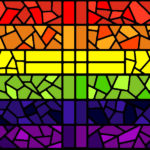

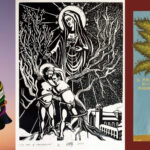

OMG, I once painted a portrait of St John of The Cross- even though I’m straight I never ealized that he was( if he lived nowadays) would be classed as LGBT!
Expressing love for God – a spiritual being – has nothing in common with sex (a physical act), and the word that you’re interpreting as “love” was just the general term for any form of affection, as numerous historians have pointed out. The strained and tedious attempt to link this to “homoeroticism” – because the second person of the Trinity took human form as a male – ignores the patent fact that it deals with mystical union with the (spiritual) Trinity, not the human Jesus (who died long before St. John of the Cross was born). This is common sense, and shouldn’t even need to be pointed out.
Nice article! My favorite poem of his, however, is THE LIVING FLAME OF LOVE… It speaks of a “tender wounding” of the soul “without oppression”…
Guy, thank you for sharing your beautiful thoughts and experience related to the medal of Jesus kissing John. I love imagining you as a youngster with your white carnation and medal of John resting his head on Jesus. The text accompanying the medal suggested that it would be “perfect for a first communion gift.”